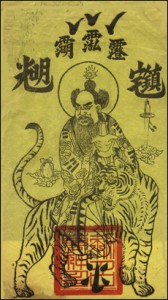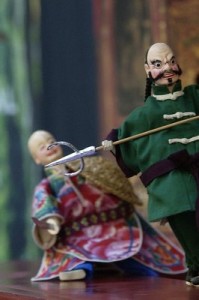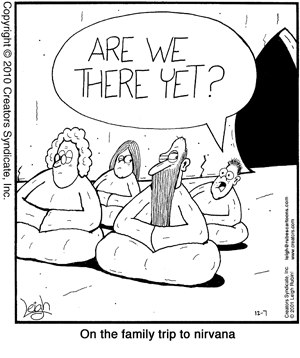
I have written elsewhere about martial arts forms being an
inheritance from the ancestors of that art.
That practicing a particular tradition is a process of reanimating the movement of the ancestors who created it. I have also written about how practicing a form may correct the errors in the form you inherited, in effect healing those in the past. And I have also written about how practicing a form can
heal your parents, your genetic ancestors, through
gongfu as a conduct correcting process.
Gongfu can be understood as a process of developing efficiency which
rectifies the inappropriate, aggressive, and wasteful movement
(jing) and breathing
(qi) habits which we learned from our parents.
All of this is akin to a daily personal exorcism. I have also argued that traditionally it was understood as an exorcism, which goes a long way toward explaining why, when itinerant beggar-monks and priests wanted to ask for money, they would perform martial arts-- demonstrating the merit-worth they had accumulated and shared through this process.*
A common criticism of Chinese Martial Arts is that it is full of empty forms. Most schools make an effort to teach "applications" for each movement in a form. Applications are demonstrations of how a conflict might transpire. But applications themselves don’t really work.
Gongfu is what works.
Gongfu is a quality of movement which has efficacy regardless of the techniques employed. If you have
gongfu, you have it when you are taking out the trash or setting the table--or even when performing an exorcism.
Conceptualization of the underlying metaphors of Chinese art and culture is key to understanding the arts in greater depth. Because people generally bring their own concepts and metaphors to the arts they inherit, it is very easy to lose sight of the vision which created the art in the first place. That loss of vision leads first to frustration and then to either radical modification or outright destruction of the arts.
But I'll come back to that later. Here is a quote from
History in Three Keys:
Some of the conclusions derived from the serious study of Chinese popular culture in the postwar decades are relevant to our understanding of the embeddedness of Boxer religious experience in... [Northern Chinese] culture. One such conclusion is that, at the village level, the sharp boundaries between the "secular" and the "sacred," to which modern Westerners are accustomed, simply did not exist. The gods of popular religion were everywhere and "ordinary people were in constant contact" with them. These gods were powerful (some, to be sure, more than others), but they were also very close and accessible. People depended on them for protection and assistance in time of need. But when they failed to perform their responsibilities adequately, ordinary human beings could request that they be punished by their superiors. Or they could punish them themselves. "If the god does not show signs of appreciation of the need of rain," Arthur Smith wrote toward the end of the nineteenth century, "he may be taken out into the hot sun and left there to broil, as a hint to wake up and do his duty." This "everydayness" of the gods of Chinese popular religion and the casual, matter-of-fact attitude Chinese typically displayed toward their deities doubtless contributed to the widespread view among Westerners, both in the late imperial period and after, that the Chinese were not an especially religious people. It would be more accurate, I believe to describe the fabric of Chinese social and cultural life as being permeated through and through with religious beliefs and practices.
But not always with the same degree of intensity and certainly not with equal discernibleness in all settings. This is another facet of Chinese popular religion that, because it does not entirely square with the expectations of Western observers, has occasioned a certain amount of confusion and perplexity. Sometimes religion appears to recede into the shadows and to be largely, if not altogether, absent from individual Chinese consciousness. But at other times it exercises dominion over virtually everything in sight. Thus, the martial arts, healing practices, and the heroes of popular literature and opera often inhabit a space in Chinese culture that seems unambiguously "secular." But it is not at all unusual, as clearly suggested in the accounts of Boxer spirit possession transcribed at the beginning of this chapter, for these selfsame phenomena to be incorporated into a fully religious framework of meaning.

Confucianism is founded on the idea that we inherit a great deal from our ancestors, including body, culture, and circumstance. We also, to some extent, inherit our will, our intentions, and our goals. The Confucian project is predicated on the idea that we have a duty to carryout and comprehend our ancestors' intentions in a way which is coherent with our own circumstance and experiences. In practice, it is entirely possible that we have two ancestors who died with conflicting goals, or an ancestor who died with an unfulfilled desire, like unrequited love, or an ancestor who wished and plotted to kill us. Our dead ancestors have become spirits whose intentions linger on in us to some extent in our habits and our reactions to stress. It is the central purpose of Confucianism to resolve these conflicts and lingering feelings of distress through a continuous process of self-reflection and upright conduct--so that we may leave a better world for our descendants. The metaphor is fundamentally one of exorcism. We empty ourselves of our own agenda so that we might consider the true will of our ancestors (inviting the spirits), then we take that understanding and transform it into action (dispersion and resolution). Finally we leave our descendants with open ended possibilities, support, and clarity of purpose (harmony, rectification, unity).
As gongfu practitioners we are emptying our practice of the inappropriate conduct of our ancestors and our teachers. The forms should be empty. That is part of the original vision of what they should be.
The theatrical exorcistic traditions (
Nuo) which I have been reading about in Jo Riley’s book
Chinese Theater and the Actor in Performance, begin with a ritual emptying of the performers/exorcists bodies. They remove the three
hun and 7
po (together ten spirits, which polarize in our bodies and which disperse at death,
hun up,
po down) and using protective talisman they put the
hun and
po in vessels for safe keeping. They can then perform the exorcisms while possessed by martial deities, spirits or powerful allied demons, without fear of harming themselves.
Jo Riley explains that the physical training of
jingju (Beijing Opera) begins with a process of emptying. The movements of Northern Shaolin form the basis of
jingju basic training. She posits that the actors have a duel role as exorcists and as performers who must be empty in order to fully embody the theatrical and religious rolls they are playing. My experience studying
Noh dance/theater in Japan directly parallels this. My
Noh teacher taught us two forms and two songs to go along with them. When we were performing we were instructed to be as empty as possible. It was explained to me that a great performer is sometimes empty enough that the actual spirit of that particular dance will descend the tree painted at the back of the stage and enter the performer.

Daoist Meditation takes emptiness as it’s root. All Daoist practices arise from this root of emptiness. The main distinction between an orthodox Daoist exorcism and a less than orthodox exorcism is in fact the ability of the priests to remain empty while invoking and enlisting various potent unseen forces (gods/demons/spirits/ancestors) to preform the ritual on behalf of a living constituency, or the recently dead.
Calligraphy was historically understood in the same way. To learn calligraphy was to copy the exact calligraphic movements of a righteous accomplished ancestor. First one would empty themselves and meditate on the ink and the blank piece paper, then on the writing to be copied. Through the brush, one would execute movements which would manifest on the page while simultaneously transforming (
zaohua) or rectifying ones heart
(zheng xin). In the mature expression of Calligraphy both as an art and for talisman making, potency is a direct result of the artist or priests ability to first empty, and then manifest the characters internally as well as on paper. That potency
(qi) is then transmitted to those who see the writing; transforming, inspiring, protecting, purifying or healing them.
Music, medicine, and cooking can all be understood this way too.
Puppetry performances,--according to my informants in Taiwan, as well as the writings of Kristofer Schipper, and Jo Riley-- are sometimes considered the most potent of all forms of ritual exorcism. This is because puppets are truly empty.
Emptiness is a key metaphor of Chinese culture. A culture which favors actions over explanations. Actions become polysemous, embedded with layers of meanings, meanings which can even seem contradictory. There is rarely an orthodoxy of meaning. The meaning of a particular action, in this case "emptiness,” can change as it traverses through strata of society, time, region, gender, family, or identity. Emptiness is a key metaphor in a “realm of action” which is operative in a very wide and varied set of contexts.
In martial arts, particularly the internal martial arts, emptiness is the basis, the ground, the root of action. We should expect the forms to be empty. We should expect to feel nothing, taste blandness, see darkness, and hear silence. When you do your forms and routines, be empty, like a puppet.
______________________
*
It's probably also true that people would donate because they thought the monks were entertaining. It's a lot less likely that they would donate because they thought the monks were ruffians. A great direction for scientific inquiry in the next few years would be to explore the relationship between ADHD and tickling. The mindfulness-meditation in the schools movement is great because it is directly addressing nervous system re-orientation problems. Basically, we can think of it as a way to trick disruptive kids into tickling themselves. Very cool.
A great direction for scientific inquiry in the next few years would be to explore the relationship between ADHD and tickling. The mindfulness-meditation in the schools movement is great because it is directly addressing nervous system re-orientation problems. Basically, we can think of it as a way to trick disruptive kids into tickling themselves. Very cool. . Instead give-in to being tickled on every spot of your body, inside and outside, that is what perfection feels like. Surrender, not retreat; in the moment, not in-control.

 I have written elsewhere about martial arts forms being an
I have written elsewhere about martial arts forms being an  Confucianism is founded on the idea that we inherit a great deal from our ancestors, including body, culture, and circumstance. We also, to some extent, inherit our will, our intentions, and our goals. The Confucian project is predicated on the idea that we have a duty to carryout and comprehend our ancestors' intentions in a way which is coherent with our own circumstance and experiences. In practice, it is entirely possible that we have two ancestors who died with conflicting goals, or an ancestor who died with an unfulfilled desire, like unrequited love, or an ancestor who wished and plotted to kill us. Our dead ancestors have become spirits whose intentions linger on in us to some extent in our habits and our reactions to stress. It is the central purpose of Confucianism to resolve these conflicts and lingering feelings of distress through a continuous process of self-reflection and upright conduct--so that we may leave a better world for our descendants. The metaphor is fundamentally one of exorcism. We empty ourselves of our own agenda so that we might consider the true will of our ancestors (inviting the spirits), then we take that understanding and transform it into action (dispersion and resolution). Finally we leave our descendants with open ended possibilities, support, and clarity of purpose (harmony, rectification, unity).
Confucianism is founded on the idea that we inherit a great deal from our ancestors, including body, culture, and circumstance. We also, to some extent, inherit our will, our intentions, and our goals. The Confucian project is predicated on the idea that we have a duty to carryout and comprehend our ancestors' intentions in a way which is coherent with our own circumstance and experiences. In practice, it is entirely possible that we have two ancestors who died with conflicting goals, or an ancestor who died with an unfulfilled desire, like unrequited love, or an ancestor who wished and plotted to kill us. Our dead ancestors have become spirits whose intentions linger on in us to some extent in our habits and our reactions to stress. It is the central purpose of Confucianism to resolve these conflicts and lingering feelings of distress through a continuous process of self-reflection and upright conduct--so that we may leave a better world for our descendants. The metaphor is fundamentally one of exorcism. We empty ourselves of our own agenda so that we might consider the true will of our ancestors (inviting the spirits), then we take that understanding and transform it into action (dispersion and resolution). Finally we leave our descendants with open ended possibilities, support, and clarity of purpose (harmony, rectification, unity). Daoist Meditation takes emptiness as it’s root. All Daoist practices arise from this root of emptiness. The main distinction between an orthodox Daoist exorcism and a less than orthodox exorcism is in fact the ability of the priests to remain empty while invoking and enlisting various potent unseen forces (gods/demons/spirits/ancestors) to preform the ritual on behalf of a living constituency, or the recently dead.
Daoist Meditation takes emptiness as it’s root. All Daoist practices arise from this root of emptiness. The main distinction between an orthodox Daoist exorcism and a less than orthodox exorcism is in fact the ability of the priests to remain empty while invoking and enlisting various potent unseen forces (gods/demons/spirits/ancestors) to preform the ritual on behalf of a living constituency, or the recently dead.